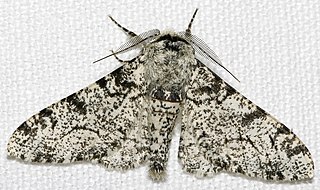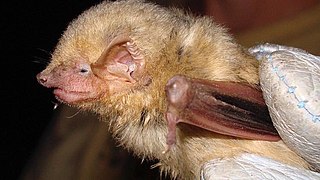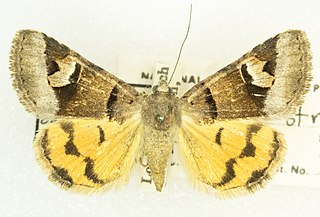Related Research Articles

In biological phylogenetics, a clade, also known as a monophyletic group or natural group, is a grouping of organisms that are monophyletic – that is, composed of a common ancestor and all its lineal descendants – on a phylogenetic tree. In the taxonomical literature, sometimes the Latin form cladus is used rather than the English form. Clades are the fundamental unit of cladistics, a modern approach to taxonomy adopted by most biological fields.

The evolution of the peppered moth is an evolutionary instance of directional colour change in the moth population as a consequence of air pollution during the Industrial Revolution. The frequency of dark-coloured moths increased at that time, an example of industrial melanism. Later, when pollution was reduced, the light-coloured form again predominated. Industrial melanism in the peppered moth was an early test of Charles Darwin's natural selection in action, and it remains a classic example in the teaching of evolution. In 1978, Sewall Wright described it as "the clearest case in which a conspicuous evolutionary process has actually been observed."

The western yellow bat is a species of vesper bat found in Mexico and the southwestern United States. This species roosts in trees such as Populus fremontii, Platanus wrightii, and Quercus arizonica. If available, the western yellow bat will use the dead fronds that encircle palm trees as a roosting site.

Drasteria is a genus of moths in the family Erebidae.

Lithophane is a genus of moths of the family Noctuidae. They spend the winter as adults. Some species are capable of feeding on other caterpillars or on sawfly larvae, which is rather uncommon among Lepidoptera.

Lithophane leeae is a moth of the family Noctuidae. It is only found in the Chiricahua Mountains in southeastern Arizona.
Drasteria hudsonica, the northern arches, is a moth of the family Erebidae. The species was first described by Augustus Radcliffe Grote and Coleman Townsend Robinson in 1865. It is found from Alaska and Yukon to California, east to New Mexico and Manitoba.

Drasteria perplexa, the perplexing or perplexed arches, is a moth of the family Erebidae. The species was first described by Henry Edwards in 1884. It is found in North America from Alberta and Saskatchewan south to Colorado and Arizona.

Drasteria sabulosa is a moth of the family Erebidae. It is found from British Columbia south into the United States where it found as far east as Wyoming, Utah, Colorado, New Mexico and as far south as Arizona.
Drasteria tejonica is a moth of the family Erebidae. It has been recorded from California, Arizona, Colorado, Utah and New Mexico.
Kenneth Gloyne Blair was an English entomologist and coleopterist. He was president of the Royal Entomological Society in 1940 and 1941 and has two portraits in the National Portrait Gallery, London.
Drasteria eubapta is a moth of the family Erebidae. It is found in North America, where it has been recorded from Arizona and California.
Aurelio José Figueredo is an American evolutionary psychologist. He is a professor of psychology, Family Studies and Human Development at the University of Arizona, where he is also the director of the Ethology and Evolutionary Psychology Laboratory. He is also a member of the interdisciplinary Center for Insect Science at the University of Arizona. His major areas of research interest are the evolutionary psychology and behavioral development of life history strategy, cognition, sex, and violence in human and nonhuman animals, and the quantitative ethology and social development of insects, birds, and primates. He is known for his research on personality, such as a 1997 study in which he and James E. King developed the Chimpanzee Personality Questionnaire to measure the Big Five personality traits in chimpanzees.

Lithophane grotei, commonly known as Grote's pinion or Grote's sallow, is a species of moth in the family Noctuidae. It was first described by Riley in 1882 and it is found in North America.

Lithophane petulca, the wanton pinion, is a species of cutworm or dart moth in the family Noctuidae. It is found in North America.

Lithophane georgii, known generally as George's pinion moth, is a species of cutworm or dart moth in the family Noctuidae. Other common names include the large grey pinion and green fruitworm. It is found in North America.
Kapi is an extinct primate genus that lived in northern India about 13.8 to 12.5 million years ago during the Miocene. The only species, K. ramnagarensis, was described in 2020 and is known from a complete lower molar. The fossil was discovered in 2015 from Ramnagar, a town in Jammu and Kashmir, for which the species name was created. Though originally identified as member of the gibbons and popularised in the news as the oldest gibbon, it was later reassessed as a pliopithecoid, a group of extinct Old World monkeys.
Yuanmoupithecus is an extinct genus of gibbons that lived 8.2 to 7.1 million years ago during the late Miocene. As of 2022, it is the oldest gibbon known. The fossils, mainly of teeth, were discovered from Yuanmou, Yunnan Province, China. The type species is Y. xiaoyuan, described by Yuerong Pan in 2006.
References
- ↑ "Walsh, Bruce, 1957–". Library of Congress Name Authority File. Retrieved 2020-04-28.
- ↑ "J. Bruce Walsh". University of Arizona. 2019-12-03. Retrieved 2020-04-28.
- ↑ Walsh, J. (2009-05-12). "Lithophane leeae (Lepidoptera, Noctuidae, Xyleninae), a striking new species from southeastern Arizona". ZooKeys (9): 21–26. Bibcode:2009ZooK....9...21W. doi: 10.3897/zookeys.9.184 . ISSN 1313-2970.
- ↑ Arizona, Bruce Walsh / University of (2009-06-10). "Pink moth discovered in Arizona". NBC News. Retrieved 2020-04-28.
- ↑ "Species Drasteria walshi". bugguide.net. Retrieved 2020-04-28.